Financial and Business Information Report: Finance Module Analysis
VerifiedAdded on 2021/02/19
|10
|2985
|429
Report
AI Summary
This report provides a comprehensive overview of financial and business information, covering a wide range of topics. It begins with definitions of work-related deductions and allowances, followed by an explanation of general interest charges and common tax issues in businesses. The report then delves into forecasting techniques, comparing ratio analysis with horizontal and vertical analysis. It further examines the roles of the Australian Securities and Investments Commission (ASIC) and the Australian Consumer Law, along with the responsibilities of the Australian Competition and Consumer Commission (ACCC). Definitions of financial products and services under the Corporations Act are provided, along with a comparison of general and special purpose financial reports. Key components of financial reports under AASB 10 are outlined, along with fair presentation and compliance requirements with AASB 101. The report also covers the compilation and importance of cash flow statements, budgetary control principles, the structure of the Australian Financial Services Industry, and the management of liquidity and interest rate risks. The report concludes by providing a detailed analysis of various aspects of finance.

Financial And Business
Information
Information
Paraphrase This Document
Need a fresh take? Get an instant paraphrase of this document with our AI Paraphraser

Table of Contents
MAIN BODY.......................................................................................................................................3
REFERENCES.....................................................................................................................................9
MAIN BODY.......................................................................................................................................3
REFERENCES.....................................................................................................................................9
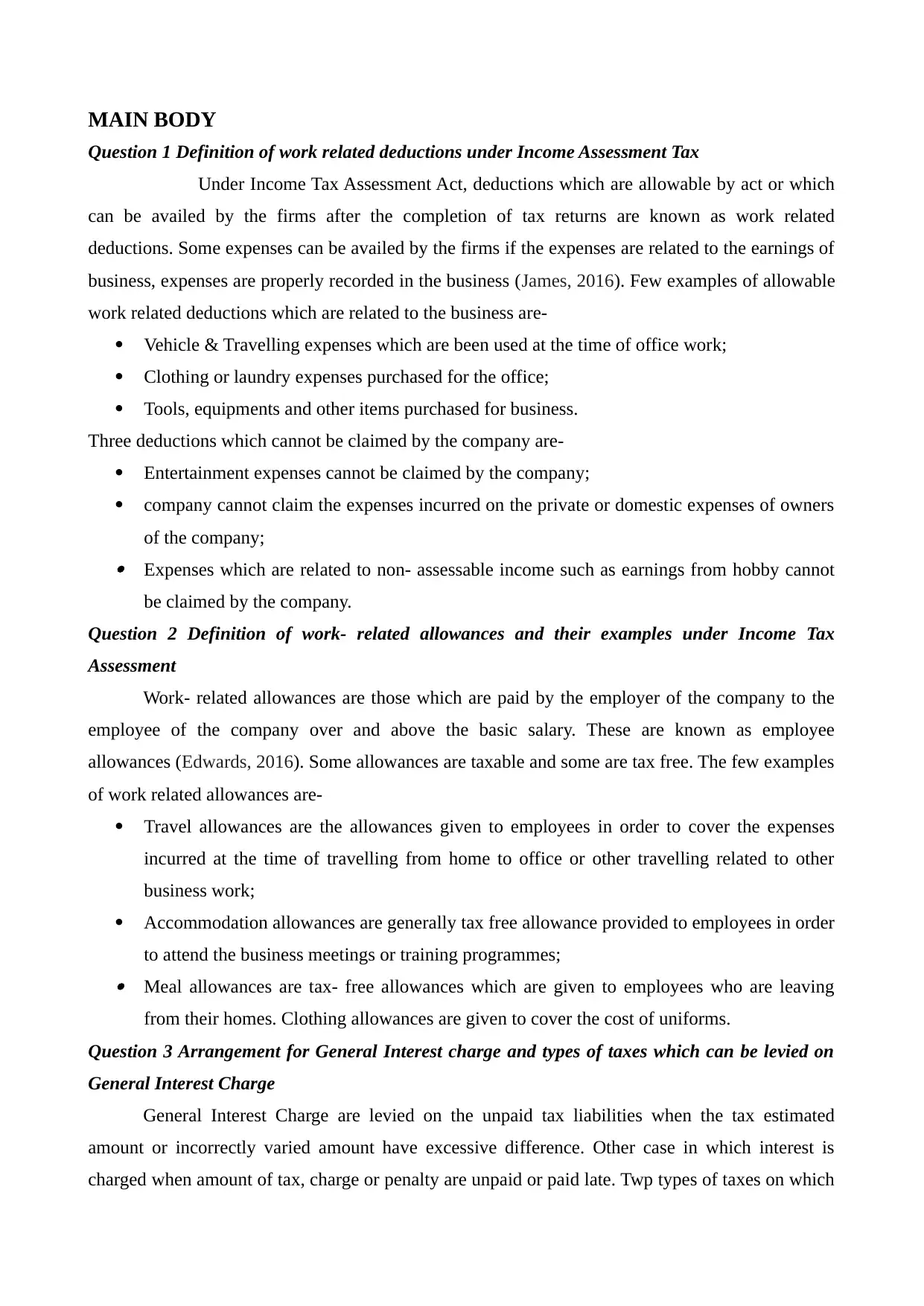
MAIN BODY
Question 1 Definition of work related deductions under Income Assessment Tax
Under Income Tax Assessment Act, deductions which are allowable by act or which
can be availed by the firms after the completion of tax returns are known as work related
deductions. Some expenses can be availed by the firms if the expenses are related to the earnings of
business, expenses are properly recorded in the business (James, 2016). Few examples of allowable
work related deductions which are related to the business are-
Vehicle & Travelling expenses which are been used at the time of office work;
Clothing or laundry expenses purchased for the office;
Tools, equipments and other items purchased for business.
Three deductions which cannot be claimed by the company are-
Entertainment expenses cannot be claimed by the company;
company cannot claim the expenses incurred on the private or domestic expenses of owners
of the company; Expenses which are related to non- assessable income such as earnings from hobby cannot
be claimed by the company.
Question 2 Definition of work- related allowances and their examples under Income Tax
Assessment
Work- related allowances are those which are paid by the employer of the company to the
employee of the company over and above the basic salary. These are known as employee
allowances (Edwards, 2016). Some allowances are taxable and some are tax free. The few examples
of work related allowances are-
Travel allowances are the allowances given to employees in order to cover the expenses
incurred at the time of travelling from home to office or other travelling related to other
business work;
Accommodation allowances are generally tax free allowance provided to employees in order
to attend the business meetings or training programmes; Meal allowances are tax- free allowances which are given to employees who are leaving
from their homes. Clothing allowances are given to cover the cost of uniforms.
Question 3 Arrangement for General Interest charge and types of taxes which can be levied on
General Interest Charge
General Interest Charge are levied on the unpaid tax liabilities when the tax estimated
amount or incorrectly varied amount have excessive difference. Other case in which interest is
charged when amount of tax, charge or penalty are unpaid or paid late. Twp types of taxes on which
Question 1 Definition of work related deductions under Income Assessment Tax
Under Income Tax Assessment Act, deductions which are allowable by act or which
can be availed by the firms after the completion of tax returns are known as work related
deductions. Some expenses can be availed by the firms if the expenses are related to the earnings of
business, expenses are properly recorded in the business (James, 2016). Few examples of allowable
work related deductions which are related to the business are-
Vehicle & Travelling expenses which are been used at the time of office work;
Clothing or laundry expenses purchased for the office;
Tools, equipments and other items purchased for business.
Three deductions which cannot be claimed by the company are-
Entertainment expenses cannot be claimed by the company;
company cannot claim the expenses incurred on the private or domestic expenses of owners
of the company; Expenses which are related to non- assessable income such as earnings from hobby cannot
be claimed by the company.
Question 2 Definition of work- related allowances and their examples under Income Tax
Assessment
Work- related allowances are those which are paid by the employer of the company to the
employee of the company over and above the basic salary. These are known as employee
allowances (Edwards, 2016). Some allowances are taxable and some are tax free. The few examples
of work related allowances are-
Travel allowances are the allowances given to employees in order to cover the expenses
incurred at the time of travelling from home to office or other travelling related to other
business work;
Accommodation allowances are generally tax free allowance provided to employees in order
to attend the business meetings or training programmes; Meal allowances are tax- free allowances which are given to employees who are leaving
from their homes. Clothing allowances are given to cover the cost of uniforms.
Question 3 Arrangement for General Interest charge and types of taxes which can be levied on
General Interest Charge
General Interest Charge are levied on the unpaid tax liabilities when the tax estimated
amount or incorrectly varied amount have excessive difference. Other case in which interest is
charged when amount of tax, charge or penalty are unpaid or paid late. Twp types of taxes on which
⊘ This is a preview!⊘
Do you want full access?
Subscribe today to unlock all pages.

Trusted by 1+ million students worldwide
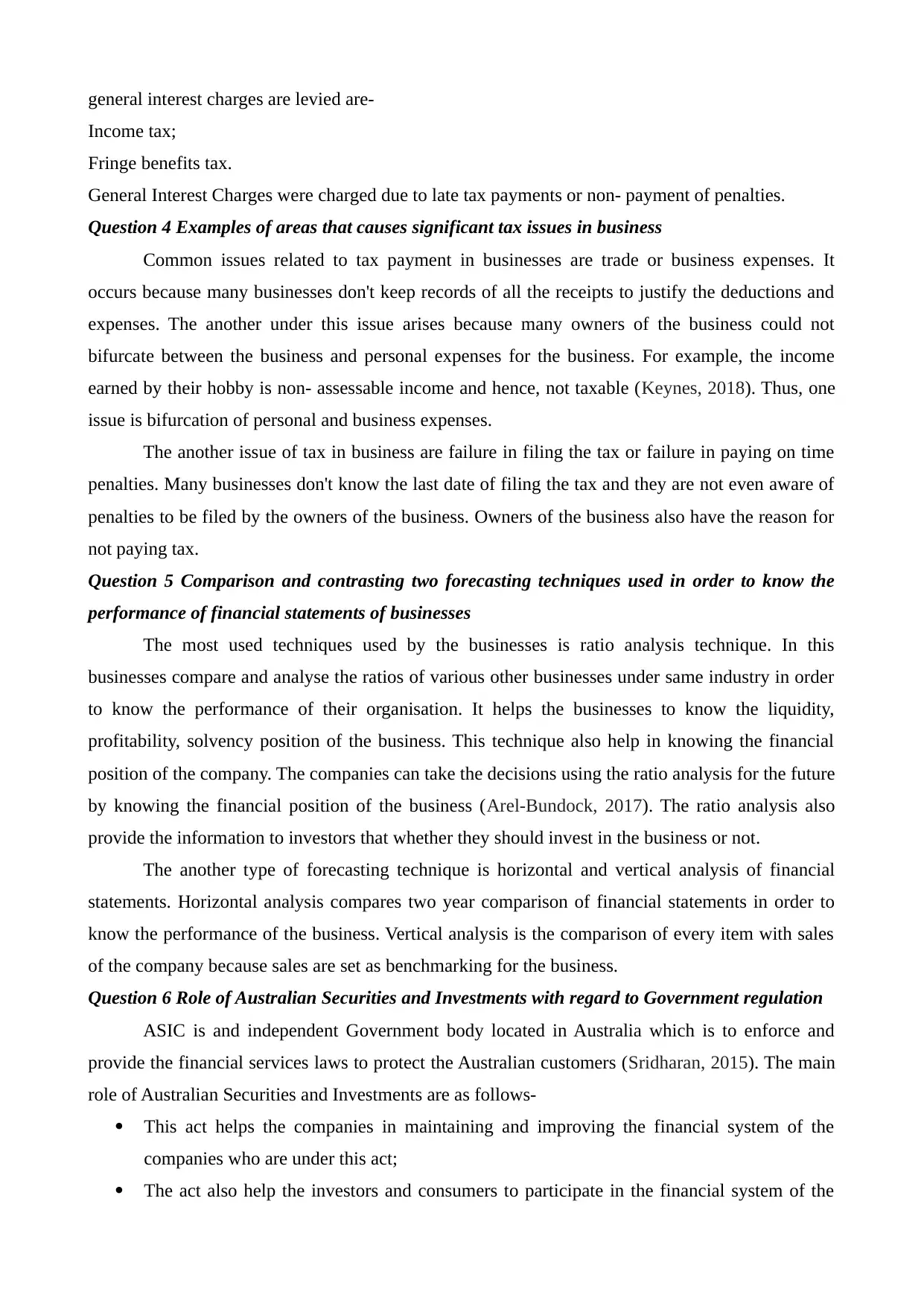
general interest charges are levied are-
Income tax;
Fringe benefits tax.
General Interest Charges were charged due to late tax payments or non- payment of penalties.
Question 4 Examples of areas that causes significant tax issues in business
Common issues related to tax payment in businesses are trade or business expenses. It
occurs because many businesses don't keep records of all the receipts to justify the deductions and
expenses. The another under this issue arises because many owners of the business could not
bifurcate between the business and personal expenses for the business. For example, the income
earned by their hobby is non- assessable income and hence, not taxable (Keynes, 2018). Thus, one
issue is bifurcation of personal and business expenses.
The another issue of tax in business are failure in filing the tax or failure in paying on time
penalties. Many businesses don't know the last date of filing the tax and they are not even aware of
penalties to be filed by the owners of the business. Owners of the business also have the reason for
not paying tax.
Question 5 Comparison and contrasting two forecasting techniques used in order to know the
performance of financial statements of businesses
The most used techniques used by the businesses is ratio analysis technique. In this
businesses compare and analyse the ratios of various other businesses under same industry in order
to know the performance of their organisation. It helps the businesses to know the liquidity,
profitability, solvency position of the business. This technique also help in knowing the financial
position of the company. The companies can take the decisions using the ratio analysis for the future
by knowing the financial position of the business (Arel-Bundock, 2017). The ratio analysis also
provide the information to investors that whether they should invest in the business or not.
The another type of forecasting technique is horizontal and vertical analysis of financial
statements. Horizontal analysis compares two year comparison of financial statements in order to
know the performance of the business. Vertical analysis is the comparison of every item with sales
of the company because sales are set as benchmarking for the business.
Question 6 Role of Australian Securities and Investments with regard to Government regulation
ASIC is and independent Government body located in Australia which is to enforce and
provide the financial services laws to protect the Australian customers (Sridharan, 2015). The main
role of Australian Securities and Investments are as follows-
This act helps the companies in maintaining and improving the financial system of the
companies who are under this act;
The act also help the investors and consumers to participate in the financial system of the
Income tax;
Fringe benefits tax.
General Interest Charges were charged due to late tax payments or non- payment of penalties.
Question 4 Examples of areas that causes significant tax issues in business
Common issues related to tax payment in businesses are trade or business expenses. It
occurs because many businesses don't keep records of all the receipts to justify the deductions and
expenses. The another under this issue arises because many owners of the business could not
bifurcate between the business and personal expenses for the business. For example, the income
earned by their hobby is non- assessable income and hence, not taxable (Keynes, 2018). Thus, one
issue is bifurcation of personal and business expenses.
The another issue of tax in business are failure in filing the tax or failure in paying on time
penalties. Many businesses don't know the last date of filing the tax and they are not even aware of
penalties to be filed by the owners of the business. Owners of the business also have the reason for
not paying tax.
Question 5 Comparison and contrasting two forecasting techniques used in order to know the
performance of financial statements of businesses
The most used techniques used by the businesses is ratio analysis technique. In this
businesses compare and analyse the ratios of various other businesses under same industry in order
to know the performance of their organisation. It helps the businesses to know the liquidity,
profitability, solvency position of the business. This technique also help in knowing the financial
position of the company. The companies can take the decisions using the ratio analysis for the future
by knowing the financial position of the business (Arel-Bundock, 2017). The ratio analysis also
provide the information to investors that whether they should invest in the business or not.
The another type of forecasting technique is horizontal and vertical analysis of financial
statements. Horizontal analysis compares two year comparison of financial statements in order to
know the performance of the business. Vertical analysis is the comparison of every item with sales
of the company because sales are set as benchmarking for the business.
Question 6 Role of Australian Securities and Investments with regard to Government regulation
ASIC is and independent Government body located in Australia which is to enforce and
provide the financial services laws to protect the Australian customers (Sridharan, 2015). The main
role of Australian Securities and Investments are as follows-
This act helps the companies in maintaining and improving the financial system of the
companies who are under this act;
The act also help the investors and consumers to participate in the financial system of the
Paraphrase This Document
Need a fresh take? Get an instant paraphrase of this document with our AI Paraphraser
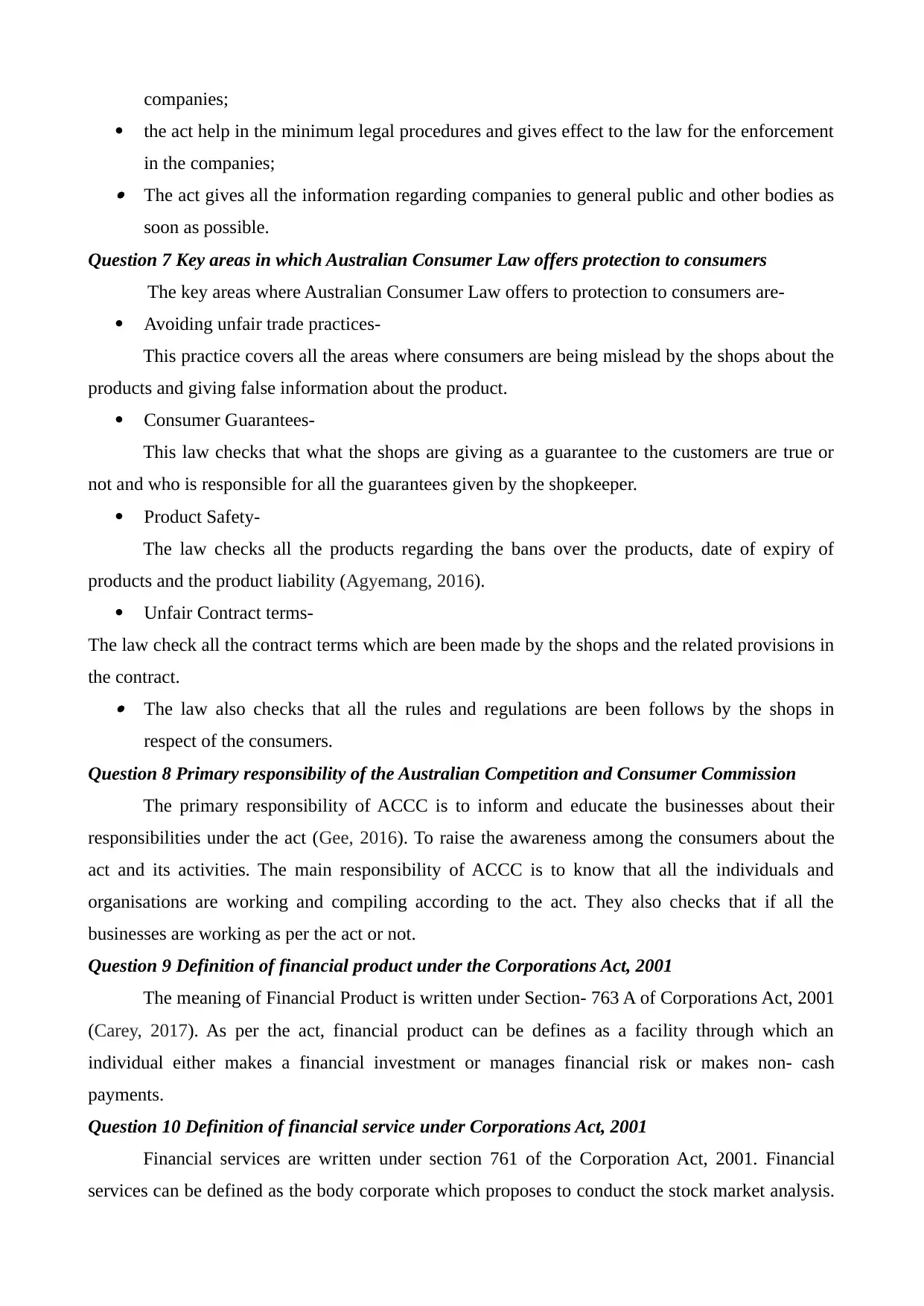
companies;
the act help in the minimum legal procedures and gives effect to the law for the enforcement
in the companies; The act gives all the information regarding companies to general public and other bodies as
soon as possible.
Question 7 Key areas in which Australian Consumer Law offers protection to consumers
The key areas where Australian Consumer Law offers to protection to consumers are-
Avoiding unfair trade practices-
This practice covers all the areas where consumers are being mislead by the shops about the
products and giving false information about the product.
Consumer Guarantees-
This law checks that what the shops are giving as a guarantee to the customers are true or
not and who is responsible for all the guarantees given by the shopkeeper.
Product Safety-
The law checks all the products regarding the bans over the products, date of expiry of
products and the product liability (Agyemang, 2016).
Unfair Contract terms-
The law check all the contract terms which are been made by the shops and the related provisions in
the contract. The law also checks that all the rules and regulations are been follows by the shops in
respect of the consumers.
Question 8 Primary responsibility of the Australian Competition and Consumer Commission
The primary responsibility of ACCC is to inform and educate the businesses about their
responsibilities under the act (Gee, 2016). To raise the awareness among the consumers about the
act and its activities. The main responsibility of ACCC is to know that all the individuals and
organisations are working and compiling according to the act. They also checks that if all the
businesses are working as per the act or not.
Question 9 Definition of financial product under the Corporations Act, 2001
The meaning of Financial Product is written under Section- 763 A of Corporations Act, 2001
(Carey, 2017). As per the act, financial product can be defines as a facility through which an
individual either makes a financial investment or manages financial risk or makes non- cash
payments.
Question 10 Definition of financial service under Corporations Act, 2001
Financial services are written under section 761 of the Corporation Act, 2001. Financial
services can be defined as the body corporate which proposes to conduct the stock market analysis.
the act help in the minimum legal procedures and gives effect to the law for the enforcement
in the companies; The act gives all the information regarding companies to general public and other bodies as
soon as possible.
Question 7 Key areas in which Australian Consumer Law offers protection to consumers
The key areas where Australian Consumer Law offers to protection to consumers are-
Avoiding unfair trade practices-
This practice covers all the areas where consumers are being mislead by the shops about the
products and giving false information about the product.
Consumer Guarantees-
This law checks that what the shops are giving as a guarantee to the customers are true or
not and who is responsible for all the guarantees given by the shopkeeper.
Product Safety-
The law checks all the products regarding the bans over the products, date of expiry of
products and the product liability (Agyemang, 2016).
Unfair Contract terms-
The law check all the contract terms which are been made by the shops and the related provisions in
the contract. The law also checks that all the rules and regulations are been follows by the shops in
respect of the consumers.
Question 8 Primary responsibility of the Australian Competition and Consumer Commission
The primary responsibility of ACCC is to inform and educate the businesses about their
responsibilities under the act (Gee, 2016). To raise the awareness among the consumers about the
act and its activities. The main responsibility of ACCC is to know that all the individuals and
organisations are working and compiling according to the act. They also checks that if all the
businesses are working as per the act or not.
Question 9 Definition of financial product under the Corporations Act, 2001
The meaning of Financial Product is written under Section- 763 A of Corporations Act, 2001
(Carey, 2017). As per the act, financial product can be defines as a facility through which an
individual either makes a financial investment or manages financial risk or makes non- cash
payments.
Question 10 Definition of financial service under Corporations Act, 2001
Financial services are written under section 761 of the Corporation Act, 2001. Financial
services can be defined as the body corporate which proposes to conduct the stock market analysis.
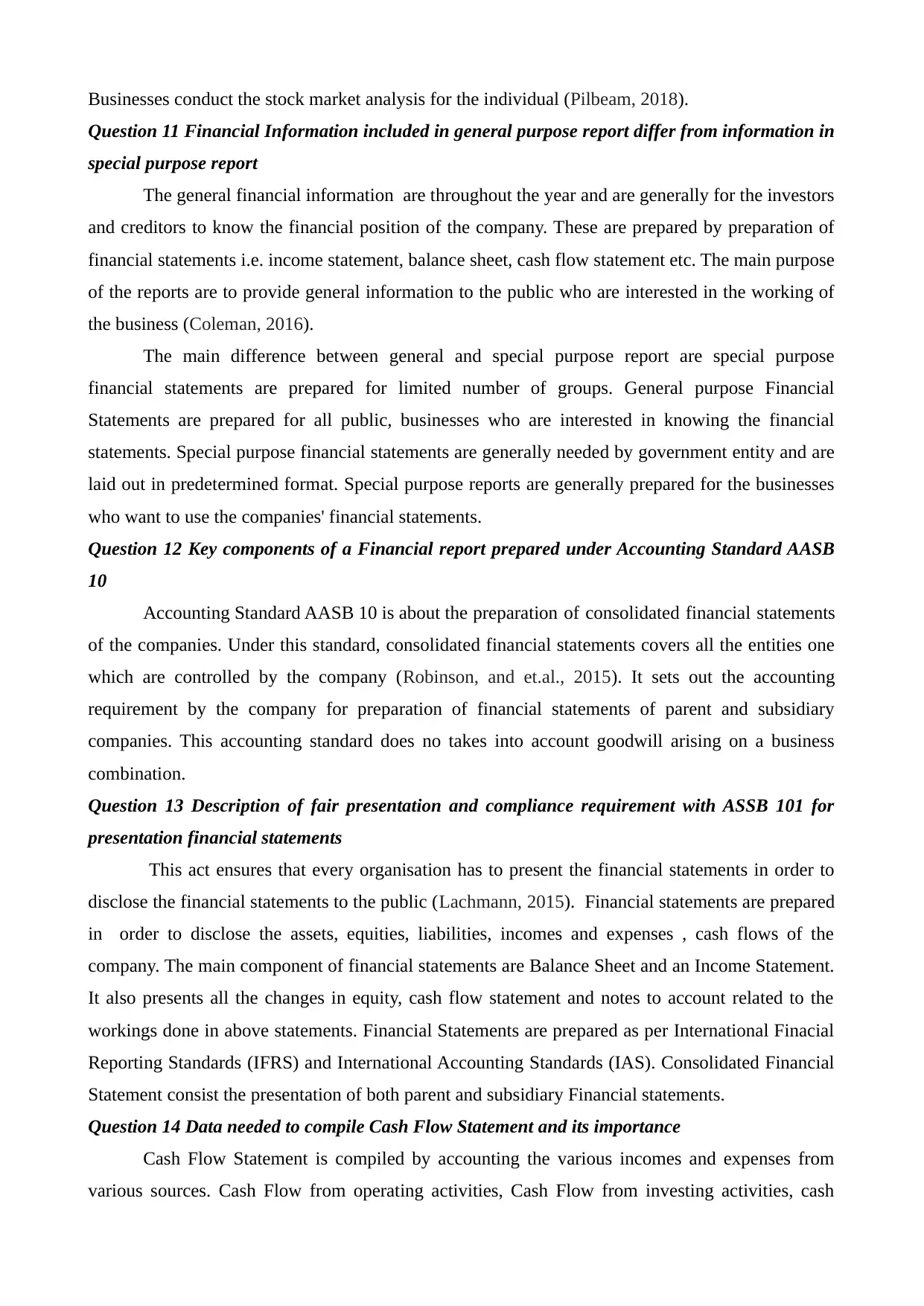
Businesses conduct the stock market analysis for the individual (Pilbeam, 2018).
Question 11 Financial Information included in general purpose report differ from information in
special purpose report
The general financial information are throughout the year and are generally for the investors
and creditors to know the financial position of the company. These are prepared by preparation of
financial statements i.e. income statement, balance sheet, cash flow statement etc. The main purpose
of the reports are to provide general information to the public who are interested in the working of
the business (Coleman, 2016).
The main difference between general and special purpose report are special purpose
financial statements are prepared for limited number of groups. General purpose Financial
Statements are prepared for all public, businesses who are interested in knowing the financial
statements. Special purpose financial statements are generally needed by government entity and are
laid out in predetermined format. Special purpose reports are generally prepared for the businesses
who want to use the companies' financial statements.
Question 12 Key components of a Financial report prepared under Accounting Standard AASB
10
Accounting Standard AASB 10 is about the preparation of consolidated financial statements
of the companies. Under this standard, consolidated financial statements covers all the entities one
which are controlled by the company (Robinson, and et.al., 2015). It sets out the accounting
requirement by the company for preparation of financial statements of parent and subsidiary
companies. This accounting standard does no takes into account goodwill arising on a business
combination.
Question 13 Description of fair presentation and compliance requirement with ASSB 101 for
presentation financial statements
This act ensures that every organisation has to present the financial statements in order to
disclose the financial statements to the public (Lachmann, 2015). Financial statements are prepared
in order to disclose the assets, equities, liabilities, incomes and expenses , cash flows of the
company. The main component of financial statements are Balance Sheet and an Income Statement.
It also presents all the changes in equity, cash flow statement and notes to account related to the
workings done in above statements. Financial Statements are prepared as per International Finacial
Reporting Standards (IFRS) and International Accounting Standards (IAS). Consolidated Financial
Statement consist the presentation of both parent and subsidiary Financial statements.
Question 14 Data needed to compile Cash Flow Statement and its importance
Cash Flow Statement is compiled by accounting the various incomes and expenses from
various sources. Cash Flow from operating activities, Cash Flow from investing activities, cash
Question 11 Financial Information included in general purpose report differ from information in
special purpose report
The general financial information are throughout the year and are generally for the investors
and creditors to know the financial position of the company. These are prepared by preparation of
financial statements i.e. income statement, balance sheet, cash flow statement etc. The main purpose
of the reports are to provide general information to the public who are interested in the working of
the business (Coleman, 2016).
The main difference between general and special purpose report are special purpose
financial statements are prepared for limited number of groups. General purpose Financial
Statements are prepared for all public, businesses who are interested in knowing the financial
statements. Special purpose financial statements are generally needed by government entity and are
laid out in predetermined format. Special purpose reports are generally prepared for the businesses
who want to use the companies' financial statements.
Question 12 Key components of a Financial report prepared under Accounting Standard AASB
10
Accounting Standard AASB 10 is about the preparation of consolidated financial statements
of the companies. Under this standard, consolidated financial statements covers all the entities one
which are controlled by the company (Robinson, and et.al., 2015). It sets out the accounting
requirement by the company for preparation of financial statements of parent and subsidiary
companies. This accounting standard does no takes into account goodwill arising on a business
combination.
Question 13 Description of fair presentation and compliance requirement with ASSB 101 for
presentation financial statements
This act ensures that every organisation has to present the financial statements in order to
disclose the financial statements to the public (Lachmann, 2015). Financial statements are prepared
in order to disclose the assets, equities, liabilities, incomes and expenses , cash flows of the
company. The main component of financial statements are Balance Sheet and an Income Statement.
It also presents all the changes in equity, cash flow statement and notes to account related to the
workings done in above statements. Financial Statements are prepared as per International Finacial
Reporting Standards (IFRS) and International Accounting Standards (IAS). Consolidated Financial
Statement consist the presentation of both parent and subsidiary Financial statements.
Question 14 Data needed to compile Cash Flow Statement and its importance
Cash Flow Statement is compiled by accounting the various incomes and expenses from
various sources. Cash Flow from operating activities, Cash Flow from investing activities, cash
⊘ This is a preview!⊘
Do you want full access?
Subscribe today to unlock all pages.

Trusted by 1+ million students worldwide
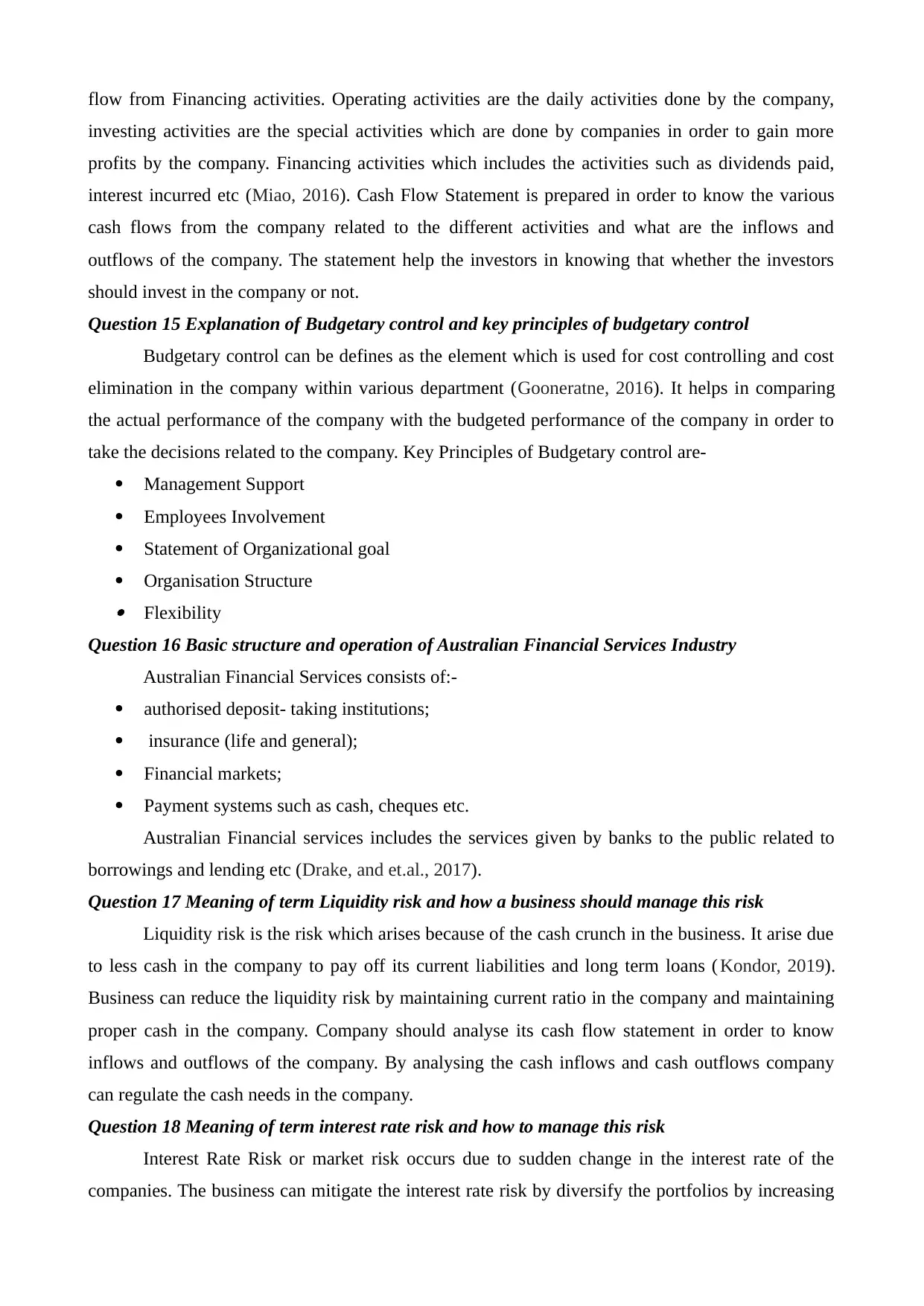
flow from Financing activities. Operating activities are the daily activities done by the company,
investing activities are the special activities which are done by companies in order to gain more
profits by the company. Financing activities which includes the activities such as dividends paid,
interest incurred etc (Miao, 2016). Cash Flow Statement is prepared in order to know the various
cash flows from the company related to the different activities and what are the inflows and
outflows of the company. The statement help the investors in knowing that whether the investors
should invest in the company or not.
Question 15 Explanation of Budgetary control and key principles of budgetary control
Budgetary control can be defines as the element which is used for cost controlling and cost
elimination in the company within various department (Gooneratne, 2016). It helps in comparing
the actual performance of the company with the budgeted performance of the company in order to
take the decisions related to the company. Key Principles of Budgetary control are-
Management Support
Employees Involvement
Statement of Organizational goal
Organisation Structure Flexibility
Question 16 Basic structure and operation of Australian Financial Services Industry
Australian Financial Services consists of:-
authorised deposit- taking institutions;
insurance (life and general);
Financial markets;
Payment systems such as cash, cheques etc.
Australian Financial services includes the services given by banks to the public related to
borrowings and lending etc (Drake, and et.al., 2017).
Question 17 Meaning of term Liquidity risk and how a business should manage this risk
Liquidity risk is the risk which arises because of the cash crunch in the business. It arise due
to less cash in the company to pay off its current liabilities and long term loans ( Kondor, 2019).
Business can reduce the liquidity risk by maintaining current ratio in the company and maintaining
proper cash in the company. Company should analyse its cash flow statement in order to know
inflows and outflows of the company. By analysing the cash inflows and cash outflows company
can regulate the cash needs in the company.
Question 18 Meaning of term interest rate risk and how to manage this risk
Interest Rate Risk or market risk occurs due to sudden change in the interest rate of the
companies. The business can mitigate the interest rate risk by diversify the portfolios by increasing
investing activities are the special activities which are done by companies in order to gain more
profits by the company. Financing activities which includes the activities such as dividends paid,
interest incurred etc (Miao, 2016). Cash Flow Statement is prepared in order to know the various
cash flows from the company related to the different activities and what are the inflows and
outflows of the company. The statement help the investors in knowing that whether the investors
should invest in the company or not.
Question 15 Explanation of Budgetary control and key principles of budgetary control
Budgetary control can be defines as the element which is used for cost controlling and cost
elimination in the company within various department (Gooneratne, 2016). It helps in comparing
the actual performance of the company with the budgeted performance of the company in order to
take the decisions related to the company. Key Principles of Budgetary control are-
Management Support
Employees Involvement
Statement of Organizational goal
Organisation Structure Flexibility
Question 16 Basic structure and operation of Australian Financial Services Industry
Australian Financial Services consists of:-
authorised deposit- taking institutions;
insurance (life and general);
Financial markets;
Payment systems such as cash, cheques etc.
Australian Financial services includes the services given by banks to the public related to
borrowings and lending etc (Drake, and et.al., 2017).
Question 17 Meaning of term Liquidity risk and how a business should manage this risk
Liquidity risk is the risk which arises because of the cash crunch in the business. It arise due
to less cash in the company to pay off its current liabilities and long term loans ( Kondor, 2019).
Business can reduce the liquidity risk by maintaining current ratio in the company and maintaining
proper cash in the company. Company should analyse its cash flow statement in order to know
inflows and outflows of the company. By analysing the cash inflows and cash outflows company
can regulate the cash needs in the company.
Question 18 Meaning of term interest rate risk and how to manage this risk
Interest Rate Risk or market risk occurs due to sudden change in the interest rate of the
companies. The business can mitigate the interest rate risk by diversify the portfolios by increasing
Paraphrase This Document
Need a fresh take? Get an instant paraphrase of this document with our AI Paraphraser
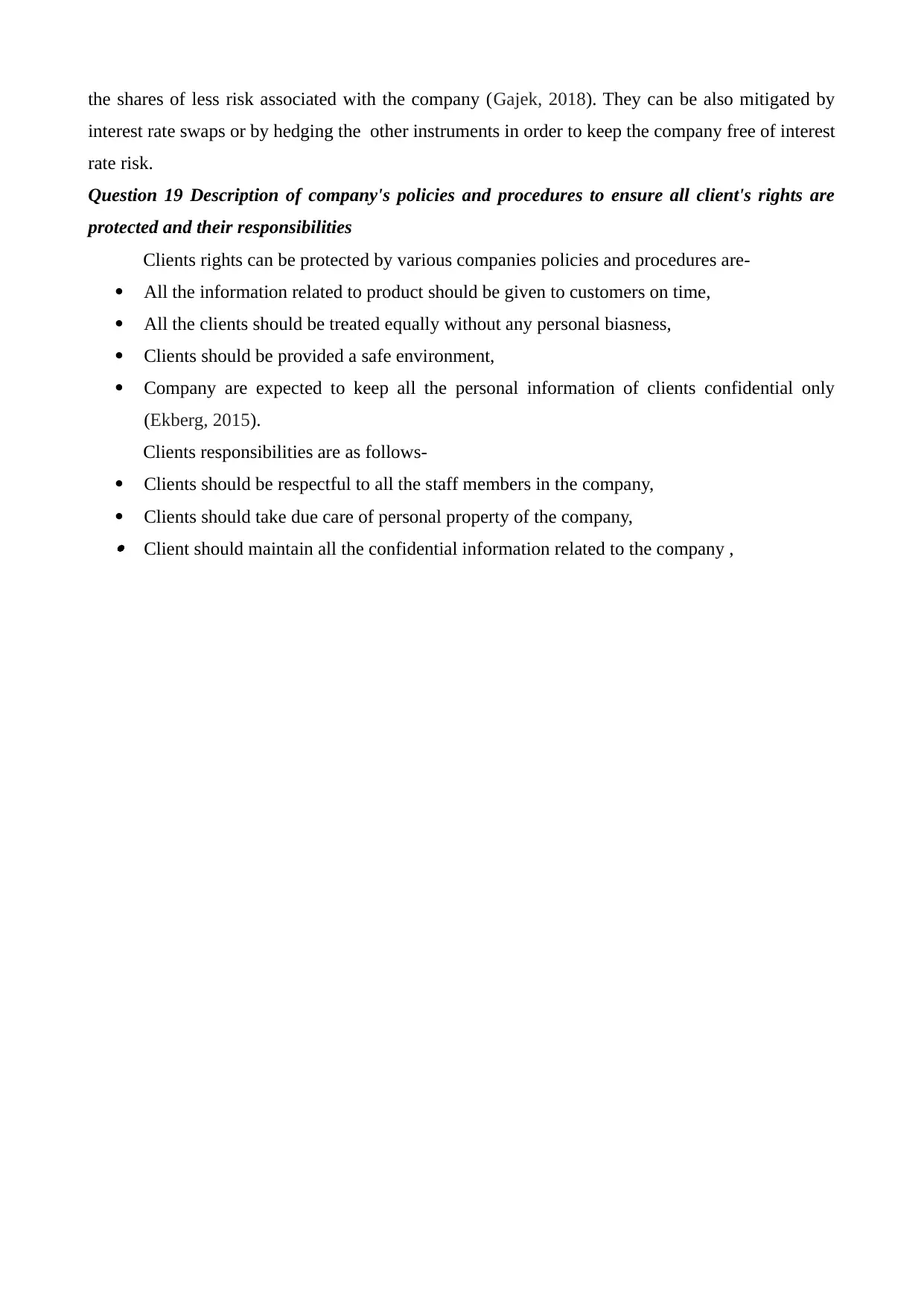
the shares of less risk associated with the company (Gajek, 2018). They can be also mitigated by
interest rate swaps or by hedging the other instruments in order to keep the company free of interest
rate risk.
Question 19 Description of company's policies and procedures to ensure all client's rights are
protected and their responsibilities
Clients rights can be protected by various companies policies and procedures are-
All the information related to product should be given to customers on time,
All the clients should be treated equally without any personal biasness,
Clients should be provided a safe environment,
Company are expected to keep all the personal information of clients confidential only
(Ekberg, 2015).
Clients responsibilities are as follows-
Clients should be respectful to all the staff members in the company,
Clients should take due care of personal property of the company, Client should maintain all the confidential information related to the company ,
interest rate swaps or by hedging the other instruments in order to keep the company free of interest
rate risk.
Question 19 Description of company's policies and procedures to ensure all client's rights are
protected and their responsibilities
Clients rights can be protected by various companies policies and procedures are-
All the information related to product should be given to customers on time,
All the clients should be treated equally without any personal biasness,
Clients should be provided a safe environment,
Company are expected to keep all the personal information of clients confidential only
(Ekberg, 2015).
Clients responsibilities are as follows-
Clients should be respectful to all the staff members in the company,
Clients should take due care of personal property of the company, Client should maintain all the confidential information related to the company ,
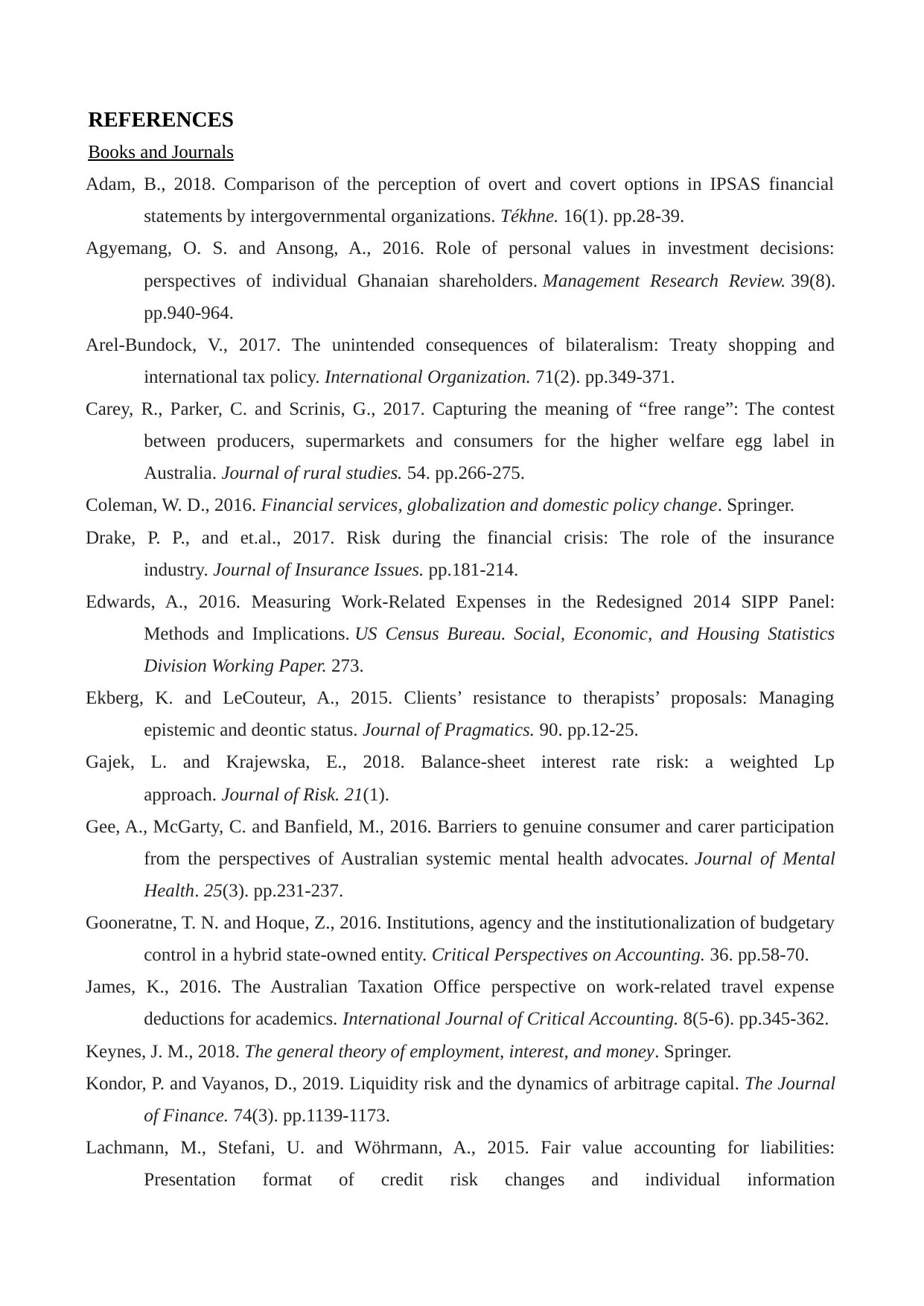
REFERENCES
Books and Journals
Adam, B., 2018. Comparison of the perception of overt and covert options in IPSAS financial
statements by intergovernmental organizations. Tékhne. 16(1). pp.28-39.
Agyemang, O. S. and Ansong, A., 2016. Role of personal values in investment decisions:
perspectives of individual Ghanaian shareholders. Management Research Review. 39(8).
pp.940-964.
Arel-Bundock, V., 2017. The unintended consequences of bilateralism: Treaty shopping and
international tax policy. International Organization. 71(2). pp.349-371.
Carey, R., Parker, C. and Scrinis, G., 2017. Capturing the meaning of “free range”: The contest
between producers, supermarkets and consumers for the higher welfare egg label in
Australia. Journal of rural studies. 54. pp.266-275.
Coleman, W. D., 2016. Financial services, globalization and domestic policy change. Springer.
Drake, P. P., and et.al., 2017. Risk during the financial crisis: The role of the insurance
industry. Journal of Insurance Issues. pp.181-214.
Edwards, A., 2016. Measuring Work-Related Expenses in the Redesigned 2014 SIPP Panel:
Methods and Implications. US Census Bureau. Social, Economic, and Housing Statistics
Division Working Paper. 273.
Ekberg, K. and LeCouteur, A., 2015. Clients’ resistance to therapists’ proposals: Managing
epistemic and deontic status. Journal of Pragmatics. 90. pp.12-25.
Gajek, L. and Krajewska, E., 2018. Balance-sheet interest rate risk: a weighted Lp
approach. Journal of Risk. 21(1).
Gee, A., McGarty, C. and Banfield, M., 2016. Barriers to genuine consumer and carer participation
from the perspectives of Australian systemic mental health advocates. Journal of Mental
Health. 25(3). pp.231-237.
Gooneratne, T. N. and Hoque, Z., 2016. Institutions, agency and the institutionalization of budgetary
control in a hybrid state-owned entity. Critical Perspectives on Accounting. 36. pp.58-70.
James, K., 2016. The Australian Taxation Office perspective on work-related travel expense
deductions for academics. International Journal of Critical Accounting. 8(5-6). pp.345-362.
Keynes, J. M., 2018. The general theory of employment, interest, and money. Springer.
Kondor, P. and Vayanos, D., 2019. Liquidity risk and the dynamics of arbitrage capital. The Journal
of Finance. 74(3). pp.1139-1173.
Lachmann, M., Stefani, U. and Wöhrmann, A., 2015. Fair value accounting for liabilities:
Presentation format of credit risk changes and individual information
Books and Journals
Adam, B., 2018. Comparison of the perception of overt and covert options in IPSAS financial
statements by intergovernmental organizations. Tékhne. 16(1). pp.28-39.
Agyemang, O. S. and Ansong, A., 2016. Role of personal values in investment decisions:
perspectives of individual Ghanaian shareholders. Management Research Review. 39(8).
pp.940-964.
Arel-Bundock, V., 2017. The unintended consequences of bilateralism: Treaty shopping and
international tax policy. International Organization. 71(2). pp.349-371.
Carey, R., Parker, C. and Scrinis, G., 2017. Capturing the meaning of “free range”: The contest
between producers, supermarkets and consumers for the higher welfare egg label in
Australia. Journal of rural studies. 54. pp.266-275.
Coleman, W. D., 2016. Financial services, globalization and domestic policy change. Springer.
Drake, P. P., and et.al., 2017. Risk during the financial crisis: The role of the insurance
industry. Journal of Insurance Issues. pp.181-214.
Edwards, A., 2016. Measuring Work-Related Expenses in the Redesigned 2014 SIPP Panel:
Methods and Implications. US Census Bureau. Social, Economic, and Housing Statistics
Division Working Paper. 273.
Ekberg, K. and LeCouteur, A., 2015. Clients’ resistance to therapists’ proposals: Managing
epistemic and deontic status. Journal of Pragmatics. 90. pp.12-25.
Gajek, L. and Krajewska, E., 2018. Balance-sheet interest rate risk: a weighted Lp
approach. Journal of Risk. 21(1).
Gee, A., McGarty, C. and Banfield, M., 2016. Barriers to genuine consumer and carer participation
from the perspectives of Australian systemic mental health advocates. Journal of Mental
Health. 25(3). pp.231-237.
Gooneratne, T. N. and Hoque, Z., 2016. Institutions, agency and the institutionalization of budgetary
control in a hybrid state-owned entity. Critical Perspectives on Accounting. 36. pp.58-70.
James, K., 2016. The Australian Taxation Office perspective on work-related travel expense
deductions for academics. International Journal of Critical Accounting. 8(5-6). pp.345-362.
Keynes, J. M., 2018. The general theory of employment, interest, and money. Springer.
Kondor, P. and Vayanos, D., 2019. Liquidity risk and the dynamics of arbitrage capital. The Journal
of Finance. 74(3). pp.1139-1173.
Lachmann, M., Stefani, U. and Wöhrmann, A., 2015. Fair value accounting for liabilities:
Presentation format of credit risk changes and individual information
⊘ This is a preview!⊘
Do you want full access?
Subscribe today to unlock all pages.

Trusted by 1+ million students worldwide
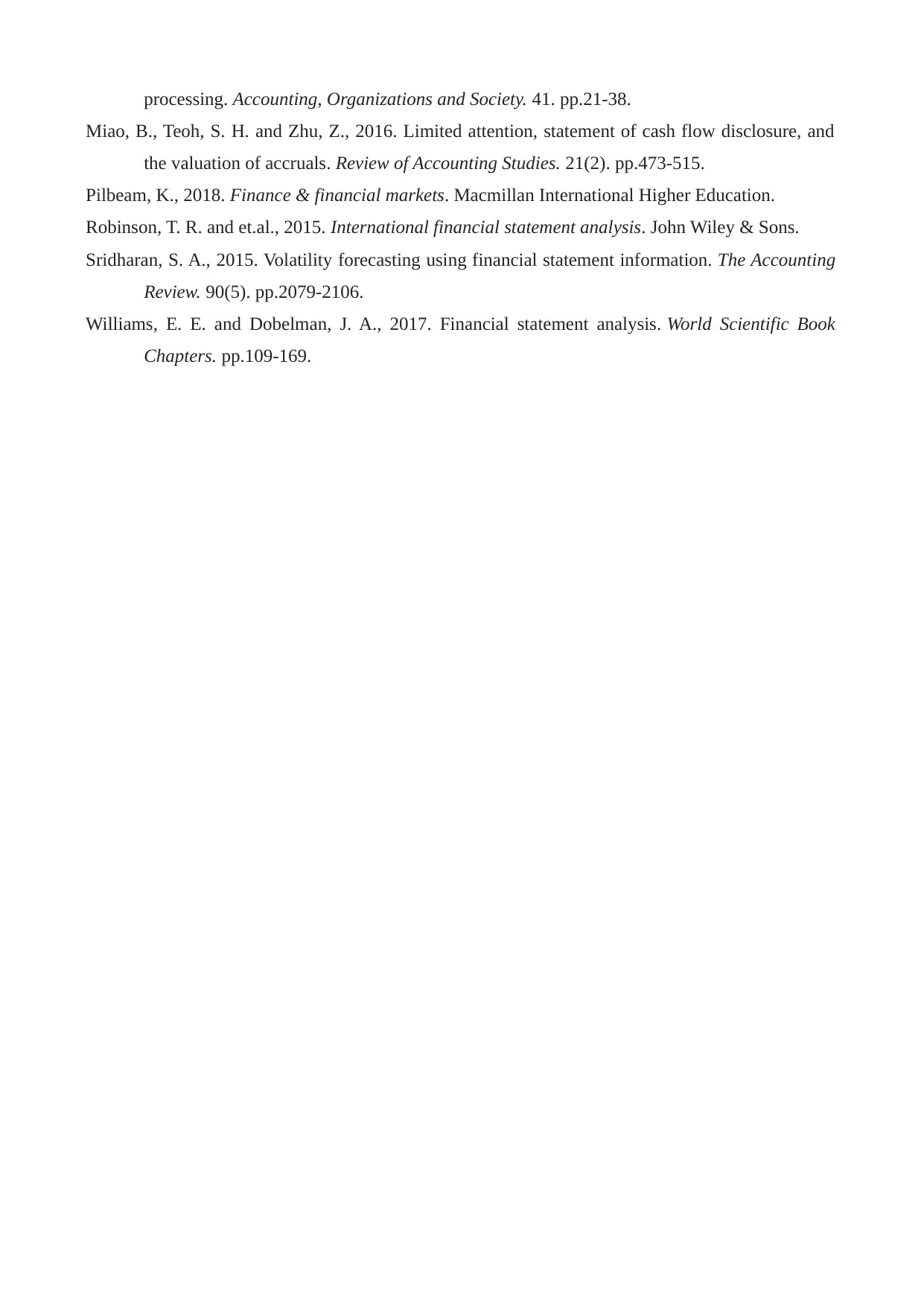
processing. Accounting, Organizations and Society. 41. pp.21-38.
Miao, B., Teoh, S. H. and Zhu, Z., 2016. Limited attention, statement of cash flow disclosure, and
the valuation of accruals. Review of Accounting Studies. 21(2). pp.473-515.
Pilbeam, K., 2018. Finance & financial markets. Macmillan International Higher Education.
Robinson, T. R. and et.al., 2015. International financial statement analysis. John Wiley & Sons.
Sridharan, S. A., 2015. Volatility forecasting using financial statement information. The Accounting
Review. 90(5). pp.2079-2106.
Williams, E. E. and Dobelman, J. A., 2017. Financial statement analysis. World Scientific Book
Chapters. pp.109-169.
Miao, B., Teoh, S. H. and Zhu, Z., 2016. Limited attention, statement of cash flow disclosure, and
the valuation of accruals. Review of Accounting Studies. 21(2). pp.473-515.
Pilbeam, K., 2018. Finance & financial markets. Macmillan International Higher Education.
Robinson, T. R. and et.al., 2015. International financial statement analysis. John Wiley & Sons.
Sridharan, S. A., 2015. Volatility forecasting using financial statement information. The Accounting
Review. 90(5). pp.2079-2106.
Williams, E. E. and Dobelman, J. A., 2017. Financial statement analysis. World Scientific Book
Chapters. pp.109-169.
1 out of 10
Related Documents
Your All-in-One AI-Powered Toolkit for Academic Success.
+13062052269
info@desklib.com
Available 24*7 on WhatsApp / Email
![[object Object]](/_next/static/media/star-bottom.7253800d.svg)
Unlock your academic potential
Copyright © 2020–2025 A2Z Services. All Rights Reserved. Developed and managed by ZUCOL.




